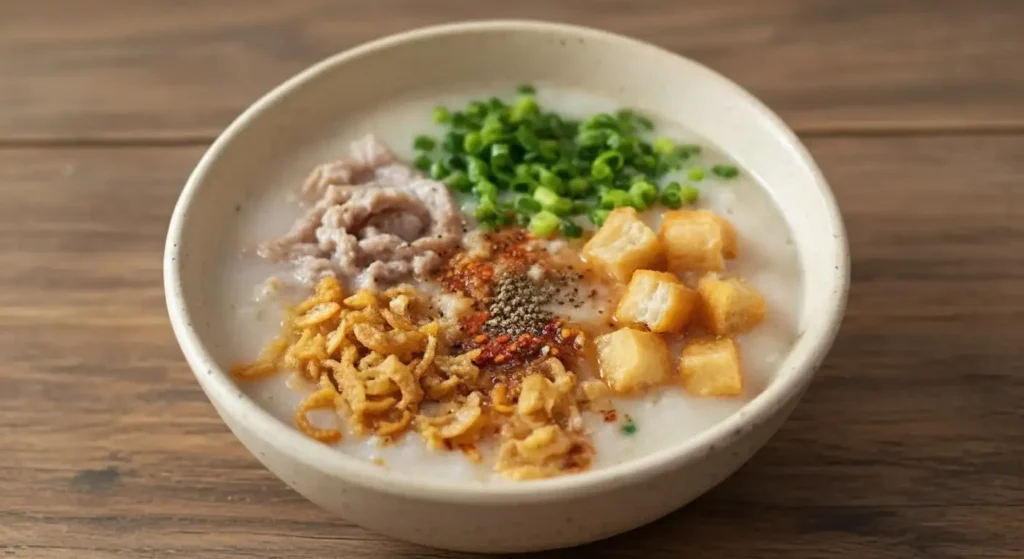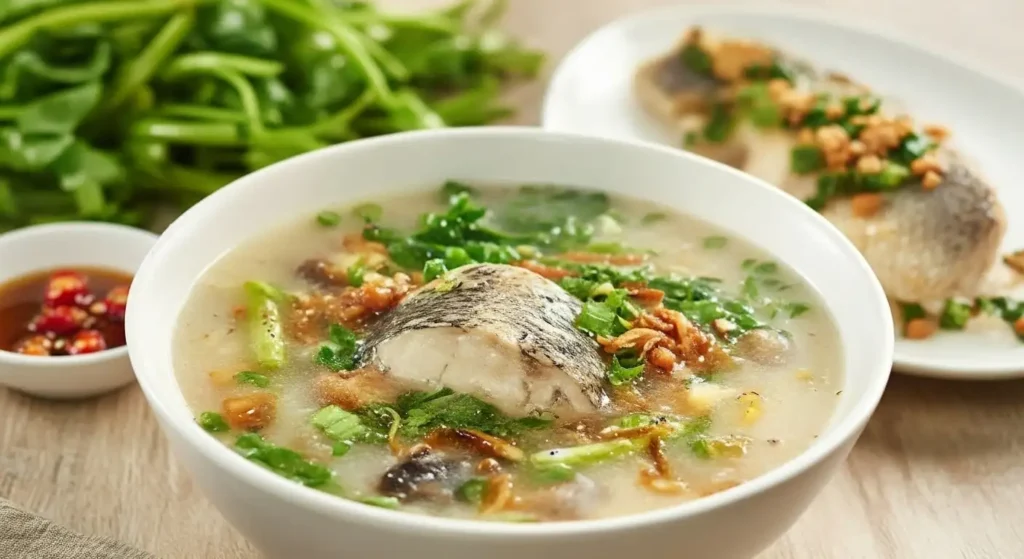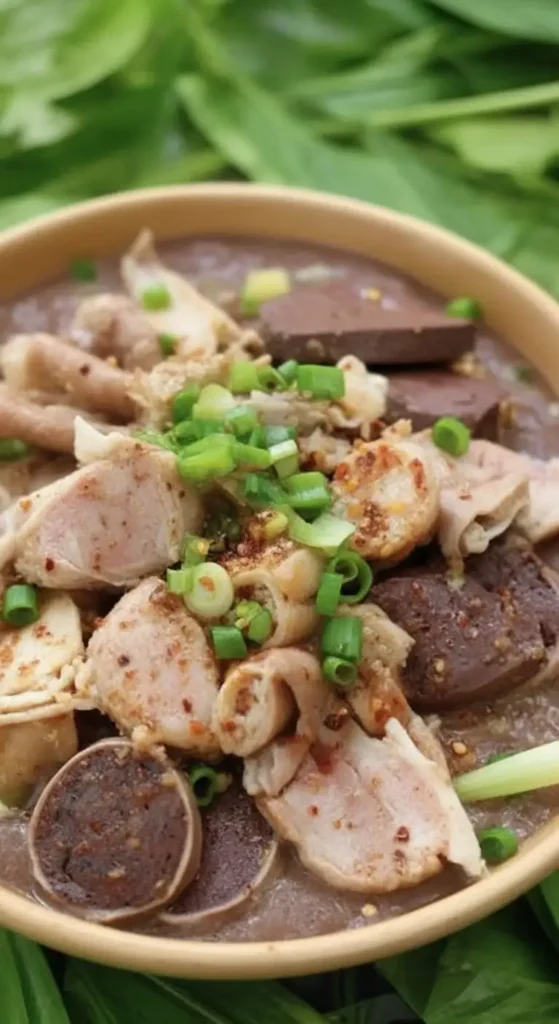Cháo (pronounced “Chow”) is the Vietnamese version of congee or rice porridge. It is a fundamental dish in the Vietnamese diet, cherished for its simplicity, nourishing qualities, and incredible versatility. Whether served as a quick, satisfying breakfast, a light meal on a cold day, or a soothing remedy for an upset stomach, Cháo is the quintessential Vietnamese comfort food.

Cháo: The Basics
The Base: Cháo is made by slowly simmering rice (usually jasmine rice) in a large amount of water or, more commonly, a savory broth (chicken, pork, or fish). The key is the long cooking time, which causes the rice grains to completely break down and “bloom,” releasing starch and transforming the liquid into a thick, creamy, homogenous porridge.
The Texture: Unlike Western rice soups, Cháo is defined by its smooth, velvety consistency. The desired thickness can vary from a thin gruel to a thick, almost paste-like porridge, depending on the region and the diner’s preference.
The Flavor Profile: The base Cháo is intentionally mild and subtle, allowing the flavors of the main protein (chicken, pork, fish) and the fresh garnishes to shine through. The broth is often infused with aromatic ingredients like ginger and onion during the cooking process.
The Core Ingredients: Rice, Water/Broth, Salt/Fish Sauce, and often a piece of sliced Ginger for warmth.
Types and Varieties of Cháo
The variations of Cháo are countless, as virtually any protein or vegetable can be incorporated.
| Vietnamese Name | Main Ingredients & Description | Focus/Flavor |
|---|---|---|
| Cháo Gà | Rice porridge simmered in chicken stock, topped with tender, shredded chicken (often the meat used to make the broth), fresh ginger, and herbs. | The classic, most popular, and universally soothing variety. |
| Cháo Lòng | A bold, robust porridge made with pork broth and various types of pig offal (innards) like heart, liver, intestines, and congealed blood (huyết). | Rich, hearty, and often considered a working-class delicacy. Not for the faint of heart! |
| Cháo Cá | Porridge made with fish broth, topped with flakes of tender white fish (often catfish or snakehead fish), and seasoned with dill, green onions, and black pepper. | Light, savory, and aromatic, often utilizing local seafood. |
| Cháo Sườn | A Northern-style porridge made thick with rice flour or finely ground rice, often served with small chunks of pork rib cartilage (sườn) and shredded pork floss (chà bông). | Thick, silky texture; a popular street food snack, especially in Hanoi. |
| Cháo Đậu Xanh | Rice cooked with mung beans until the beans dissolve into the porridge, giving it a greenish-yellow hue and a slightly earthy, nutty flavor. Can be sweet or savory. | Nutritious, simple, and comforting. |

How to Eat Cháo
Cháo is almost never eaten plain; the final presentation and assortment of toppings and condiments are essential to the experience.
The Condiments: The bowl of Cháo is a canvas for flavor:
Fried Shallots (Hành Phi): Essential for a savory crunch and an onion-sweet aroma.
Herbs: Sliced green onions (hành lá), cilantro (ngò), and sometimes Vietnamese mint.
Spice: Freshly ground black pepper and sliced chili peppers (or chili oil).
Seasoning: A final dash of fish sauce (nước mắm) or soy sauce for added umami.
The Side Dish (Quẩy): A key accompaniment, particularly in the North, is Quẩy (or Dầu Cháo Quẩy), which are long, crispy, deep-fried dough sticks similar to Chinese Youtiao. These are broken and dipped into or soaked in the hot porridge, adding a pleasant chewiness and absorbing the savory broth.
Eating: Cháo is served piping hot in a bowl and is eaten with a spoon. It’s often eaten quickly, typically as a breakfast or late-night snack.
Regional Differences
The differences in Cháo across Vietnam are subtle, primarily reflecting the regional preferences for seasoning and locally available ingredients.
| Region | Flavor Profile & Typical Cháo | Key Differences |
|---|---|---|
| Northern Vietnam (Hanoi) | Subtle, Pure, Thick. Reflects the Northern emphasis on balanced, clean, and less overly sweet or spicy flavors. | Prefers a thicker, creamier consistency (like the Cháo Sườn made with rice flour). Toppings are simpler, favoring shredded meat and herbs over a large array of ingredients. The Quẩy is an indispensable side. |
| Central Vietnam (Huế/Đà Nẵng) | Bold and Spicy. Aligning with the Central palate's love for intensity. | Cháo is often seasoned more strongly, with liberal use of chili or chili paste. Unique local seafood like different types of small fish are often used for Cháo Cá, giving it a distinctive regional taste. |
| Southern Vietnam (Ho Chi Minh City) | Liquidy, Open, Diverse. Reflects the region's diverse culinary influences and tropical abundance. | Tends to have a slightly thinner, soupier consistency. Ingredients are more varied, including seafood (shrimp, squid) and sometimes a touch of sweetness (sugar or rock sugar) in the broth. The range of herbs and fresh vegetables used for garnish is much wider. |




